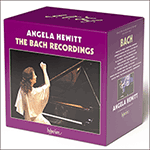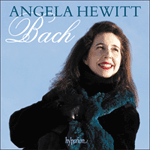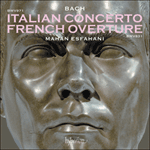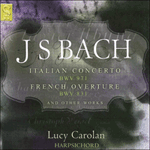
Welcome to Hyperion Records, a British classical label devoted to presenting high-quality recordings of music of all styles and from all periods from the twelfth century to the twenty-first.
Hyperion offers both CDs, and downloads in a number of formats. The site is also available in several languages.
Please use the dropdown buttons to set your preferred options, or use the checkbox to accept the defaults.

These dance movements follow, beginning with a Courante (the usual allemande is omitted). The first thing to remember here is that the French dance of this name is very different from the Italian corrente. The latter is almost a virtuoso showpiece; the former is ranked with the sarabande as one of the slowest triple-metre dances in the suite. Its qualities are described as serious, solemn, noble and earnest by the theoreticians of the time. It is also marked by rhythmic ambiguities in its 3/2 metre. Bach brings this out beautifully in the left hand of this Courante, which lands on every other beat in the opening two bars. Then we have two graceful Gavottes, the first using semiquaver ‘tirades’, the second restricting itself to the lower register and demanding a change of colour. One of the most attractive dances of the suite comes next – the Passepied. Again in a pair, the first of these opens with an energetic trill that propels us to the end of the phrase. The usual definition of a passepied as a ‘fast minuet’ ignores its more vigorous accentuation and off-beat accents (such as in the alto voice of bars 5 to 6 and 29 to 30). The second Passepied is much calmer, resembling a musette with its drone bass. Mattheson described the passepied as frivolous, but pleasant – ‘just as many a female who, though she is a little inconstant, nevertheless does not therewith lose her charm’.
The core of the suite is occupied by a beautiful Sarabande. This dance, besides being noted for its noble character, is also intense, passionate, and meant to disturb the tranquillity of the mind. A certain ‘nonchalance’ was required to dance it: impeccable carriage of the head and body, but at the same time being alert and ready to execute any movement. A description dating from 1671 gives us some idea of the effect it made: ‘Now and then he [the dancer] would express anger and spite with an impetuous and turbulent rhythmic unit; and then, evoking a sweeter passion by more moderate motions, he would sigh, swoon, let his eyes wander languidly; and certain sinuous movements of the arms and body, nonchalant, disjointed and passionate, made him appear so admirable and so charming that throughout this enchanting dance he won as many hearts as he attracted spectators.’
In this particular Sarabande, Bach clearly adopts the French tradition of accenting the second beat of the bar, making it the high point of the phrase. It is also very contrapuntal, with unusual dissonances and swift modulations. A perfect legato without the use of the pedal is needed to do it justice.
Bourrées are often played far too quickly. Although energetic and joyful (lustig), they still need to be danceable. While the first of another pair in this suite uses the characteristic two-note upbeat and syncopation in bar 4, the second is unorthodox in using three notes as an upbeat. Again the range is considerably lower than its partner. The French Gigue that follows is a perfect example of what it should be: lightly skipping, sprightly, with the constant use of the ‘sautillant’ figure. It should not be anxious or frenzied. The phrases can be clearly marked to make it more intelligible to the listener. Only towards the end does the left hand become more involved, rather than just accompanying, with extra ‘tirades’ adding to the excitement.
The work could end here, but it doesn’t. Instead Bach gives us his pièce de résistance, the Echo, to top it all off. Though obviously orchestral (we think of the famous Badinerie concluding the B minor Orchestral Suite), Bach makes dramatic use of the two keyboards by writing in echoes that require a rapid change of manual. On the piano, of course, this is a bit less dramatic, but the effect must still be there. The actual echoes do not always simply repeat what has gone before but often ornament it, adding that extra stroke of genius. Scheibe declared that Bach’s music ‘is exceedingly difficult to play because the efficiency of his own limbs sets his standards’. Fortunately Bach made no compromises!
from notes by Angela Hewitt © 2001
Les mouvements de danse se succèdent donc ensuite, inaugurés par une Courante (à noter l’absence de l’allemande traditionnelle). Il faut tout d’abord se rappeler que la danse française du nom de courante est très différente de la corrente italienne. Si celle-ci constitue quasiment un morceau de bravoure virtuose, celle-là fait partie, avec la sarabande, des danses ternaires modérées, voire lentes, de la suite. Les théoriciens de l’époque la caractérisent par ses qualités de sérieux, de solennel, de noble et de fervent. Elle abonde en ambiguïtés rythmiques au sein de sa mesure à 3/2. Bach l’illustre à merveille dans sa Courante comme en témoignent les deux premières mesures de la main gauche réalisée en hémiole. Apparaissent ensuite deux gracieuses Gavottes, la première exploitant des «tirades» de doubles croches, tandis que la seconde reste confinée dans le registre grave du clavier et appelle des changements de couleurs sonores. Vient ensuite une des danses les plus attachantes de la suite, le Passepied, conçue une fois encore en diptyque. Le premier Passepied s’ouvre par un trille énergétique qui nous propulse à la fin de la phrase. La définition habituelle du passepied, un «menuet rapide», ignore son accentuation la plus rigoureuse et ses déplacements rythmiques (comme l’hémiole à la voix d’alto aux mesures 5 à 6 et 29 à 30). Plus calme, le second Passepied ressemble à une musette de par ses quintes à vide à la basse. Mattheson décrivait le passepied comme étant de nature frivole mais plaisante—«comme de nombreuses femmes qui tout en étant un peu inconstantes, ne perdent point leur charme».
C’est une splendide Sarabande qui est au cœur de la suite. Se distinguant par son caractère noble, mais aussi intense et passionné, cette danse aspirait à troubler la tranquillité de l’esprit. Une certaine «nonchalance» était de mise: un impeccable port de la tête et du corps qui préservait toutefois la vivacité de mouvement. Une description de 1671 donne une bonne idée de l’effet qu’elle produisait: «De temps en temps, [le danseur] exprimait la colère et le dépit avec un élan rythmique impétueux et turbulent; puis, évoquant une passion plus douce par une allure plus modérée, il soupirait, se pâmait, laissait ses yeux vagabonder avec langueur; et certains mouvements sinueux de ses bras et de son corps, nonchalants, disjoints et passionnés, le rendaient si admirables, si charmant que durant cette danse enchanteresse il s’est gagné autant de cœurs qu’il y avait de spectateurs.»
Dans le cas présent, Bach adopta clairement la tradition française consistant à accentuer le deuxième temps de la mesure, de façon à en faire l’apogée de la phrase. Particulièrement contrapuntique, riche de dissonances rares et de modulations rapides, cette Sarabande exige, pour que justice lui soit rendue, un jeu d’un legato parfait sans l’aide de la pédale.
Les bourrées ne sont que trop souvent exécutées avec une rapidité qui frise la précipitation. Même si leur caractère est énergétique, elles sont avant tout destinées à être dansées. Alors que la première Bourrée incorpore l’anacrouse et la syncope (mesure 4) habituelles, la seconde sort des normes établies avec trois notes en guise de levée. De plus, son registre est nettement plus grave que sa contrepartie. La Gigue française qui suit est un exemple parfait de ce qu’elle devrait être: légèrement sautillante, pétillante, elle emploie constamment le rythme pointé caractéristique. Elle ne recèle ni anxiété ni précipitation. Pour la rendre plus intelligible à l’oreille, il faut marquer clairement le phrasé. Ce n’est que vers la conclusion que la main gauche devient de plus en plus présente, outrepassant son rôle accompagnateur, avec des traits supplémentaires qui ajoutent à la verve enthousiaste.
L’Ouverture pourrait s’achever ainsi, mais il n’en est rien. Au contraire, Bach nous livre alors sa pièce de résistance intitulée Echo. Conçue d’un point de vue orchestral (on peut à cet égard évoquer la fameuse Badinerie de la Suite pour orchestre en si mineur), Bach exploite dramatiquement les deux claviers avec une écriture en écho qui requiert de rapides changements de manuels. Au piano, bien entendu, l’effet est un peu moins dramatique, mais doit toujours être présent. Les échos ne sont pas de simples reprises de ce qui vient d’être entendu, mais souvent une version ornée qui permet d’entrapercevoir le génie de Bach. Scheibe déclarait que la musique de Bach est «extrêmement difficile à exécuter parce que c’est l’efficacité de ses propres doigts qui établissent ses standards [de jeu]». Heureusement que Bach ne se laissa tenter par aucun compromis!
extrait des notes rédigées par Angela Hewitt © 2001
Français: Isabelle Battioni
Die erwähnten Tanzsätze schließen sich an, angefangen mit einer Courante (die gewohnte Allemande wird ausgelassen). Zuallererst gilt es hier zu beachten, daß der französische Tanz dieses Namens sich erheblich vom italienischen corrente unterscheidet, der fast schon ein virtuoses Schaustück ist; die Courante gehört (zusammen mit der Sarabande) zu den langsamsten Tänzen im Dreiertakt im Rahmen der Suite. Sie wird von den Theoretikern der Zeit als ernst, feierlich, edel und innig beschrieben. Außerdem ist sie durch rhythmische Mehrdeutigkeit im Rahmen ihres 3/2-Metrums gekennzeichnet. Bach bringt dies hier wunderbar zur Geltung, indem er die linke Hand in den ersten beiden Takten in Hemiolen schreiten lässt. Es folgen zwei elegante Gavotten, von denen die erste Sechzehnteltiraden einsetzt, während sich die zweite auf das tiefe Register beschränkt und eine Änderung der Klangfarbe verlangt. Als nächstes kommt einer der reizvollsten Tänze der Suite—der Passepied. Wiederum sind es hier zwei, und der erste setzt mit einem energischen Triller ein, der uns zum Ende der Phrase hinführt. Die übliche Definition des Passepied als „schnelles Menuett“ berücksichtigt nicht dessen robustere Akzentuierung und die Akzente auf dem schwachen Taktteil (wie in der Altstimme der Takte 5/6 und 29/30). Der zweite Passepied ist erheblich ruhiger und erinnert mit seinem Bordun an eine Musette. Mattheson hat den Passepied als frivol, aber angenehm beschrieben und mit einer Frau verglichen, die ein wenig wankelmütig sein mag, dadurch aber nichts von ihrem Charme einbüßt.
Den Kern der Suite bildet eine wunderschöne Sarabande. Dieser Tanz ist einerseits für seinen edlen Charakter bekannt, andererseits aber auch intensiv, leidenschaftlich und dazu gedacht, den Hörer aus seiner Gemütsruhe aufzurütteln. Um die Sarabande zu tanzen, wurde eine gewisse Nonchalance verlangt: untadelige Körper- und Kopfhaltung, doch zugleich Wachsamkeit und die Bereitschaft, jede Bewegung auszuführen. Eine Beschreibung aus dem Jahr 1671 vermittelt uns einen Eindruck davon, welchen Effekt sie hatte: „Hin und wieder brachte er [der Tänzer] mit einer ungestümen und turbulenten rhythmischen Schrittfolge Wut und Boshaftigkeit zum Ausdruck; durch gemessenere Bewegungen eine süßere Leidenschaft heraufbeschwörend seufzte er sodann, schmolz dahin und ließ matt die Blicke schweifen; und gewisse geschmeidige Körper- und Armbewegungen, nonchalant, unzusammenhängend und leidenschaftlich, ließen ihn so bewundernswert, so charmant erscheinen, daß er im Verlaufe dieses bezaubernden Tanzes ebenso viele Herzen gewann, wie er Zuschauer anzog.“
In der vorliegenden Sarabande macht sich Bach eindeutig die französische Tradition zu eigen, den zweiten Schlag des Takts zu betonen, so daß er zum Höhepunkt der Phrase wird. Sie ist zudem äußerst kontrapunktisch gesetzt, mit ungewöhnlichen Dissonanzen und schnellen Modulationen. Um ihr gerecht zu werden, ist ein makelloses Legato ohne Pedaleinsatz vonnöten.
Bourrées werden oft viel zu schnell gespielt. Obwohl sie energisch und „lustig“ zu sein haben, müssen sie doch stets tanzbar bleiben. Während die erste Bourrée eines weiteren Paares in dieser Suite den charakteristischen zweitönigen Auftakt und Synkopierung im Takt 4 aufweist, ist die zweite insofern unorthodox, als sie zum Auftakt drei Töne benutzt. Wieder ist die Tonlage des zweiten Tanzes wesentlich tiefer als die des ersten. Die anschließende französische Gigue ist ein Musterbeispiel ihrer Gattung: locker hüpfend, munter, unter ständigem Einsatz einer (mit der Rhythmusangabe „sautillant“ versehenen) Figur. Sie darf keinesfalls bemüht oder aufgeregt klingen. Die Phrasen können klar voneinander abgesetzt werden, um sie für den Hörer leichter verständlich zu machen. Erst gegen Ende wird die linke Hand zunehmend beschäftigt, statt nur zu begleiten, und zusätzliche Tiraden tragen zur Erregung bei.
Das Werk könnte hier enden, doch statt dessen bietet uns Bach zur Krönung sein pièce de résistance, das Echo. Obwohl es offensichtlich orchestral angelegt ist (wir werden an die berühmte Badinerie erinnert, mit der die Orchestersuite in h-Moll schließt), macht sich Bach auf dramatische Weise die beiden Tastaturen zunutze, indem er Echos schreibt, die rasche Manualwechsel erfordern. Auf dem Flügel ist dies natürlich nicht ganz so dramatisch, aber der Effekt muß trotzdem hörbar sein. Die Echos selbst wiederholen nicht immer nur das Vorangegangene, sondern verzieren es oft—ein besonderer Geniestreich. Dazu Scheibe: „Weil er nach seinen [eigenen] Fingern urtheilt, so sind seine Stücke überaus schwer zu spielen.“ Glücklicherweise ist Bach keine Kompromisse eingegangen!
aus dem Begleittext von Angela Hewitt © 2001
Deutsch: Anne Steeb/Bernd Müller
 Bach: Angela Hewitt – The Bach Recordings Bach: Angela Hewitt – The Bach Recordings‘One of the record glories of our age’ THE SUNDAY TIMES. For the first time ever, Angela Hewitt’s complete recordings of the Bach keyboard works on Hyperion are presented in one collection of 27 CDs. This covers nearly 25 years of Angela’s Bach re ...» More |
 Bach: Angela Hewitt plays Bach Bach: Angela Hewitt plays BachAngela Hewitt’s acclaimed recordings of Bach on the piano have received the highest critical acclaim and found their way into thousands of homes, selling nearly 400,000 copies since her recording of the Inventions burst onto the scene in 1994. Now ...» More |
 Bach: Italian Concerto & French Overture Bach: Italian Concerto & French OvertureMahan Esfahani again highlights the radicalism, virtuosity and sheer joyousness of all the works recorded here.» More |
 Bach: Italian Concerto & French Overture Bach: Italian Concerto & French OvertureA second volume of Lucy Carolan's recordings of Bach's keyboard music, including unique and constrasted pieces such as the Italian Concerto and the French Overture.» More |

